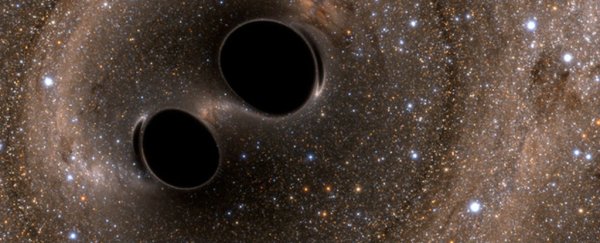If we want to find extra dimensions lurking within our Universe - something that string theory attempts to explain - gravitational waves could be our key to locating them, physicists suggest.
This new hypothesis seeks to answer the long-standing mystery of why gravity appears to be weaker than the other fundamental forces in our Universe, by proposing that it's actually 'leaking out' into extra dimensions we're yet to detect.
"Extra dimensions have been discussed for a long time from different points of view," Emilian Dudas from the École Polytechnique in France, who wasn't involved in the study, told Leah Crane at New Scientist.
"Gravitational waves could be a new twist on looking for extra dimensions."
Right now, we're pretty comfortable with the idea of a four-dimensional Universe - three spatial dimensions plus time as the fourth.
But there are a lot of gaps in our understanding of how matter behaves on the smallest scales that an extra six dimensions could help fill - in fact, according to string theory, the Universe would make a lot more sense if it were made up of 10 dimensions.
As one of the most promising avenues by which physicists could finally close the gap between classical and quantum physics, string theory is not easily ignored.
String theory proposes that the smallest building blocks of matter we've managed to detect, called quarks, are actually made up of something even tinier - one-dimensional filaments of energy that look like vibrating strings.
These 'strings' are an enticing possibility for physicists, because they can actually do something that current physics can't - they can describe all known forces of nature at once: gravity, electromagnetism, and the nuclear forces.
They could also help us make sense of the fact that the Universe's expansion appears to be accelerating.
The only problem is that, in order to be mathematically feasible, these strings require at least 10 physical dimensions, and right now, we're not even close to finding one extra dimension.
But physicists Gustavo Lucena Gómez and David Andriot from the Max Planck Institute for Gravitational Physics in Germany think they have a pretty good way of looking for them - Einstein's famous gravitational waves.
Gravitational waves were the biggest story in science last year, when researchers at LIGO - two enormous observatories in Louisiana and California - announced that they'd finally found direct evidence of the ripples in space-time that Einstein had predicted 100 years prior.
Gravitational waves are like sound waves, travelling through space at the speed of light, prompted by some of the most violent events in our Universe, such as black holes merging or stars exploding.
They'd also feasibly run through all dimensions present in the Universe - even those that are too small for us to detect.
"If there are extra dimensions in the Universe, then gravitational waves can walk along any dimension, even the extra dimensions," Gómez told New Scientist.
Gómez and Andriot came up with a mathematical model to describe how the effects of hidden dimensions on gravitational waves would look, and found two key factors: extra waves would exist at high frequencies, and gravitational waves would stretch the fabric of the Universe differently across extra dimensions.
They describe that first factor as a "massive tower" of extra gravitational waves with frequencies so high, our current detectors can't find them - LIGO would need to be thousands of times more sensitive to get a look-in.
"If such a detector were available, however, one could hope for a very clean signal, since there is no known astrophysical process emitting gravitational waves with frequencies much greater than 1,000 Hz," they propose.
"Such high frequencies may thus be clear symptoms of new physics."
The second factor - something they call the "breathing mode" - would require physicists looking at anomalies in how 'normal' gravitational waves (i.e. the ones we can detect now) stretch or shrink space-time.
"The breathing mode deforms the space in a specific manner, giving a distinct signature," they write.
To observe this change, says Hannah Osborne at Newsweek, they would need three detectors like LIGO all working to observe the same thing at the same time - something that "should be available in a near future", the scientists predict.
The idea not only gives us a new way of looking for extra dimensions - it could also help us address one of the biggest questions in physics: the relative 'weakness' of gravity as a fundamental force in the Universe.
It could be that gravity is 'leaking' out into the six extra dimensions we can't see, so we only know about a fraction of its influence on the Universe across the four dimensions we can actually measure it in.
We should point out that this hypothesis is in its very early stages - it's yet to be peer-reviewed, so we can expect all kinds of opinions from the physics community regarding its veracity, both good and bad.
Theoretical physicist Bobby Acharya, from King's College London in the UK, told Newsweek he firmly believes there are extra dimensions in the Universe that we're yet to detect, but we might struggle finding them using gravitational waves because they're so small.
"That means that in order to excite them and create waves in those extra dimensions, you require a lot of energy," he told Osborne.
"And if you did produce the gravitational wave that propagated in the extra dimensions, the fact that extra dimensions are so small it means the frequency of this gravitational wave will be very high - much higher than the LIGO gravitational wave detectors can detect."
We've got a long way to go before this idea becomes even close to technically viable, but if there really are more dimensions in the Universe than we know about it, we're just glad someone's thinking about how to find them.
The research has been published on the pre-print website, arXiv.org.
